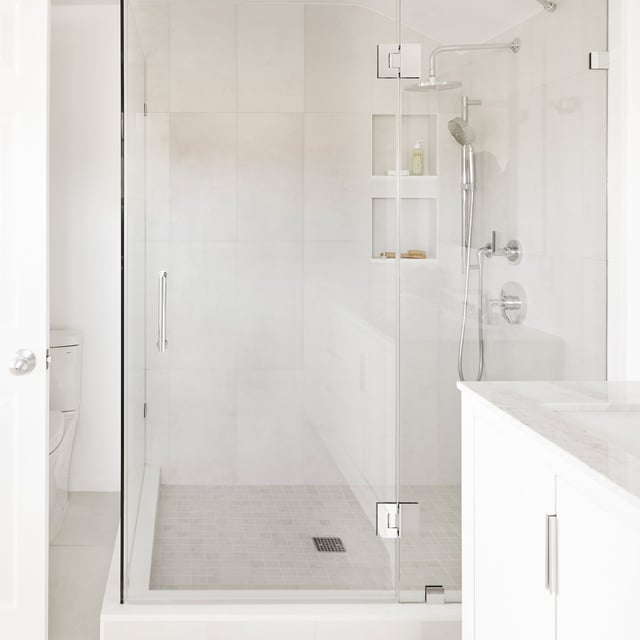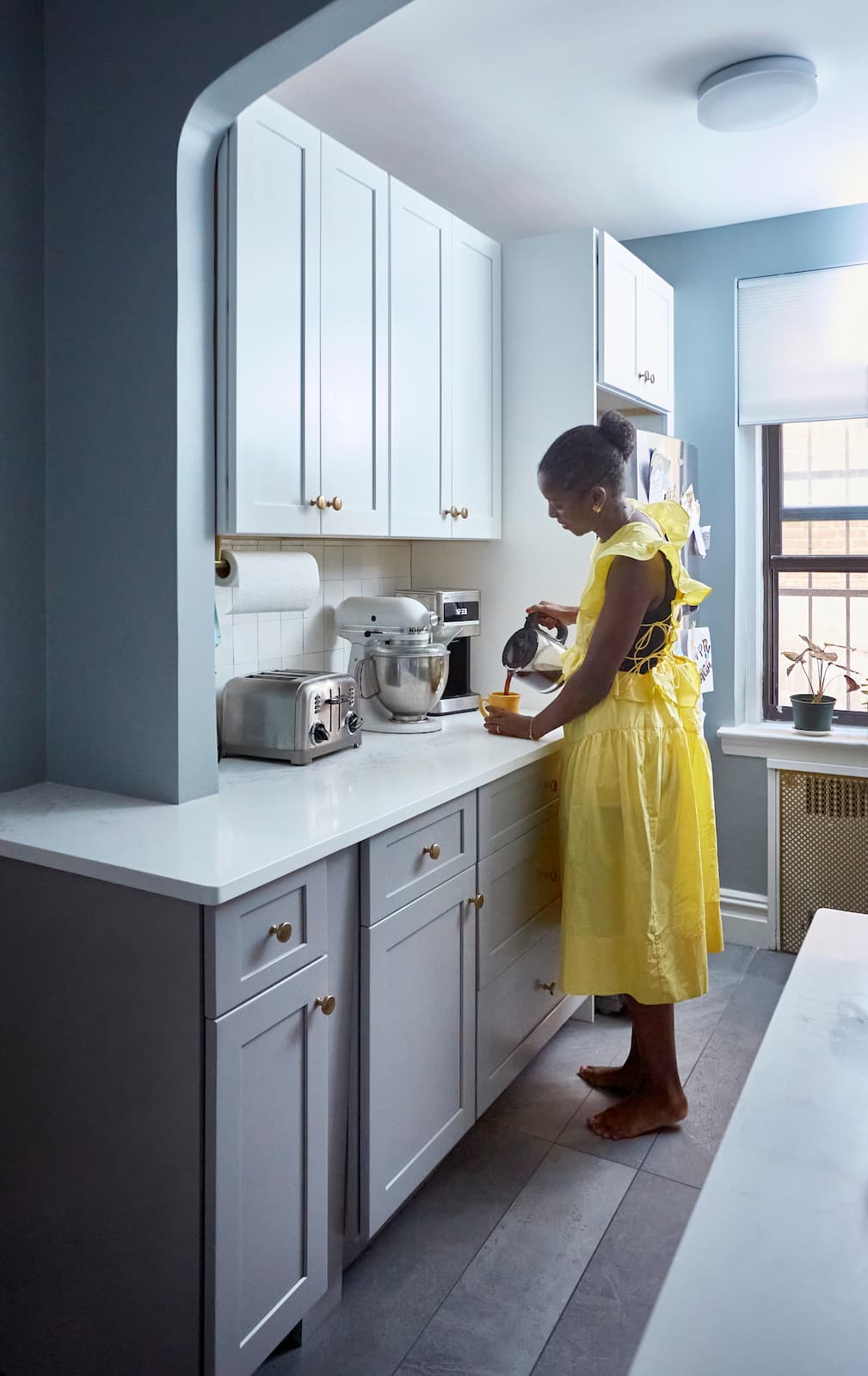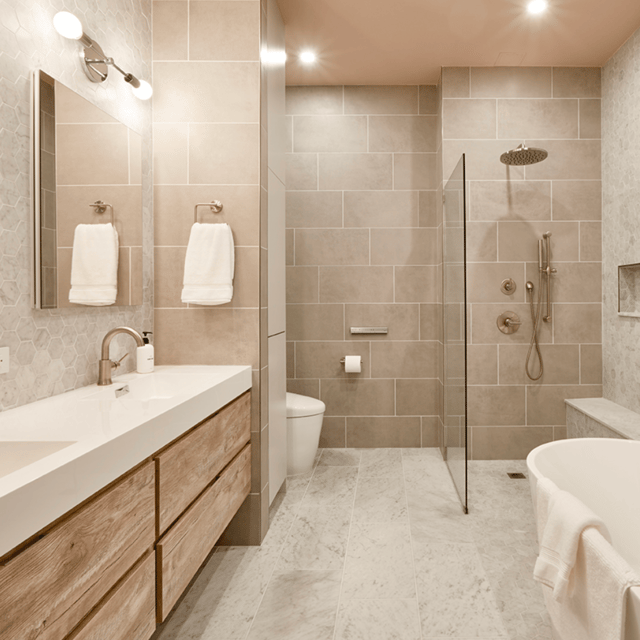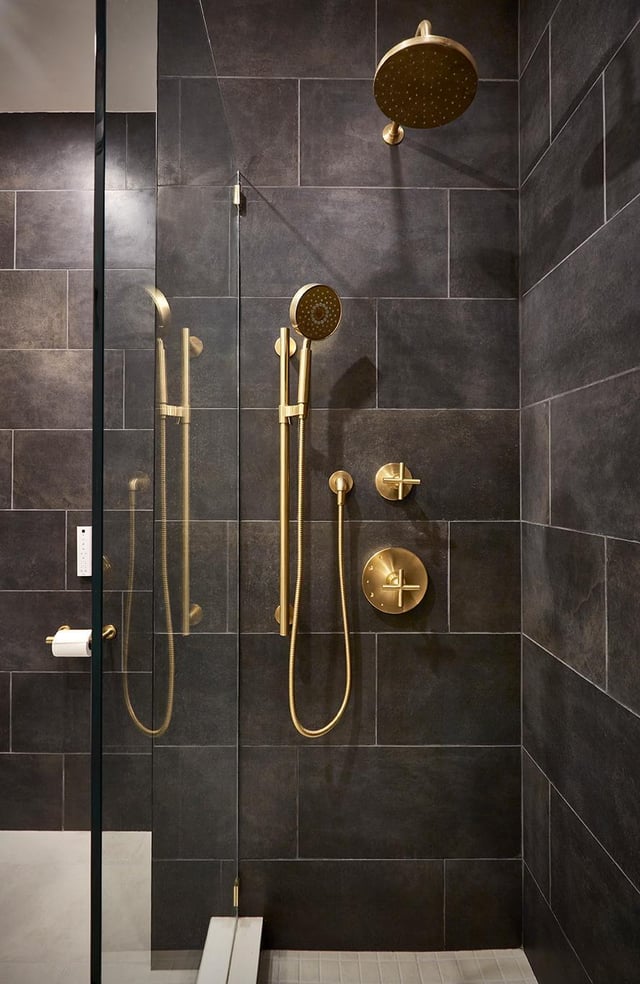
Bathroom
Eco-Friendly Shower & Bathroom Ideas
12.23.2025
Our New Year savings event is here: Get up to $6,500 off your project today (terms apply).


In This Article
Limited storage, tight layouts, and a lack of flexible space are just a few of the challenges of renovating a small house. However, you can make every square foot count with careful planning and innovative design solutions. This guide covers essential considerations and practical ideas to transform your small home into a more functional and comfortable space.
Before you dive into design choices or product selections, take time to clarify your main reason for renovating. Is your top priority to create a more relaxing, spa-like retreat? Do you need to improve storage and organization for a growing family? Maybe you want to update outdated fixtures, enhance accessibility, or boost your home’s resale value.
It’s helpful to distinguish between your primary goal—the outcome that matters most to you—and your secondary goals, which are still important but less critical. For example, your primary goal might be to improve accessibility, while a secondary goal could be to upgrade the lighting or add heated floors. It’s not about cost—it’s about what matters most to you.
Getting clear on what matters most—whether it's a spa-like soak or space to store toddler bath toys—makes it easier to prioritize if plans need to shift. If you need to scale back, you’ll know exactly which features or upgrades you’re willing to adjust, and which ones are non-negotiable. This clarity will guide your planning, help you communicate with your contractor, and ensure a successful renovation.
Pinpointing your design inspiration early on will make the rest of the renovation process smoother. A clear vision helps you select the right contractor while allowing you to communicate your expectations and preferences with confidence.
Start by browsing online galleries, design blogs, and social media platforms to see what styles, colors, and layouts resonate with you. To see real-world before-and-after examples and discover all that is possible, check out Block Renovation’s gallery of remodeled bathrooms.
Try our Bathroom Remodel Visualizer Tool to experiment with different finishes and layouts for a more interactive approach. This can help you visualize your ideas and make more informed choices.
If you want a truly personalized design, consider hiring an interior designer. An experienced designer can assess your bathroom’s layout and suggest ways to improve flow, such as reconfiguring the shower, vanity, or toilet placement to maximize both function and comfort. They can recommend materials and finishes that match your aesthetic and stand up to moisture and daily use.
Interior designers are skilled at identifying opportunities for custom storage, like built-in shelving or recessed niches, and can help you select lighting that enhances both task and ambiance. They can also create detailed renderings or mood boards to help you visualize the finished space, and ensure that every design choice—from tile patterns to hardware—works together harmoniously.
Design a Home That’s Uniquely Yours
Block can help you achieve your renovation goals and bring your dream remodel to life with price assurance and expert support.
Get Started
Once you’ve clarified your goals and gathered inspiration, it’s time to establish your budget for your bathroom renovation. Start by researching the typical costs for the type of remodel you’re planning, factoring in materials, labor, permits, and a contingency for unexpected expenses. Be honest about what you can comfortably afford, and remember to prioritize your primary goals when allocating funds.
To help with budgeting, consult with the guides below:
If your ideal renovation exceeds your allotted budget, consider exploring financing options. Home equity loans, personal loans, or renovation-specific financing programs can help you bridge the gap, but understand the terms and long-term impact on your finances.
Establishing your budget and financing strategy early will help you make informed choices, avoid unnecessary stress, and keep your project on track from start to finish.
Selecting the right contractor is one of the most important decisions for your bathroom renovation. Block Renovation takes the guesswork out of this process by shortlisting experienced local contractors whose expertise and design aesthetic aligns with your own.
Each contractor is carefully screened for quality, insurance, and customer satisfaction, so you can feel confident in their expertise. You’ll receive personalized recommendations based on your project’s needs and style, along with clear, competitive quotes and access to reviews and references, making it easier to choose the right professional for your bathroom renovation.
Bring Your Dream Bathroom to Life

One of the first steps you and your contractor should take is to review your renovation plans in the context of local building codes and regulations. Building codes exist to ensure safety, accessibility, and proper construction standards. Even seemingly minor changes—like moving plumbing, altering electrical wiring, or changing the size of a window—can have code implications or require permits.
Work with your contractor to identify any aspects of your plans that may require securing permits or requests for exemptions to building codes. Anticipating these needs early helps you avoid costly delays, fines, or the need to redo work.
If you live in a condo or co-op, be sure to check with your building management for any additional rules or approval processes that may apply to your renovation.
For additional information on the subject, check out A Guide to Bathroom Remodel Permits in NYC.
Take a thorough inventory of your existing bathroom with your contractor. Decide together which elements can be salvaged, reused, or repurposed, and which should be removed or replaced. For example, you might choose to keep a structurally sound bathtub and reglaze it for a fresh look, or retain existing plumbing lines to save on costs. On the other hand, outdated or damaged fixtures, cabinetry, or tile may be best replaced to achieve your desired outcome.
Your contractor can help assess the condition and compatibility of existing features with your new design. They can also advise on the cost-benefit of reusing versus replacing certain items. Being intentional about what stays helps control your budget, while reducing waste and streamlining the renovation process. Make sure to document these decisions in your project plan so everyone is on the same page when work begins.
With your goals, inspiration, and budget in place, it’s time to make definitive selections for all the materials and fixtures that will go into your new bathroom. This includes everything from tile, flooring, and paint colors to vanities, sinks, faucets, lighting, mirrors, and hardware. Work closely with your contractor during this phase as they can provide valuable insight into the durability, maintenance, and installation requirements of different products. Your contractor may also have access to trade discounts or recommend suppliers with a reputation for quality and reliability.
Be sure to review samples in person whenever possible, as colors and textures can look different in your home’s lighting compared to online or in a showroom. Confirm lead times for any custom or special-order items to ensure they’ll arrive before needed in the construction schedule.
Making these decisions early and communicating them clearly to your contractor will help prevent delays and ensure your renovation stays on track.
These questions help you zoom in on what matters most—so the final result isn’t just new, but genuinely works for you and your family. By clarifying your priorities and discussing them with your contractor, you’ll reduce the risk of misunderstandings and be more likely to achieve a result you’ll love.
If you’re ambiguous on any of the above questions, take the time to iron out your answers before charging headfirst into the next steps of a renovation.
Your bathroom renovation can officially begin once all the planning, selections, and approvals are complete. Understanding each step of the process—and what’s expected from both your contractor and you as the homeowner—will help ensure a smooth, successful project.
Walk through the space with your contractor, clarify any concerns, and confirm which items will be protected, salvaged, or removed. Provide access to the work area and clear out personal belongings.
Your contractor will install dust barriers, floor protection, and ventilation as needed to minimize disruption to the rest of your home. They will also set up a staging area for tools and materials.
Ensure pets and family members avoid the work zone for the duration of the project. Confirm arrangements for alternative bathroom use if this is your only bathroom.
The team will carefully remove old fixtures, cabinetry, tile, and other elements slated for replacement. They should handle debris removal and disposal according to local regulations and inspect for hidden issues such as mold, rot, or outdated wiring/plumbing.
Next comes the installation or relocation of plumbing lines, electrical wiring, and venting according to the new layout. Your contractor will frame new walls, niches, or supports as needed. At this time, it’s common for your contractor to schedule required inspections before closing up walls.
Your contractor will install backer board, waterproof membranes, and any necessary underlayment for tile and flooring. They’ll ensure all wet areas (showers, tub surrounds) are properly sealed to prevent future water damage. For more insights into this part of the checklist, read Bathroom Waterproofing—Floors, Walls & More.
This is when your contractor will lay tile for floors, walls, and shower enclosures and install grout and sealant. Finally, it’s time to paint the walls and ceiling.
The contractor will install the vanity, sink, toilet, bathtub or shower, faucets, lighting, mirrors, and any built-in cabinets or shelving. They will also connect all plumbing and electrical fixtures.
Now is the time to add hardware like towel bars, hooks, and toilet paper holders. Your contractor should caulk seams and touch up paint as needed.
Renovate with confidence every step of the way
Step 1: Personalize Your Renovation Plan
Step 2: Receive Quotes from Trusted Contractors
Step 3: Let Us Handle the Project Details

A bathroom renovation can uplift your quality of life and the resale value of your house, but only if the work is done right.
To help you hire your next bathroom remodeler in days, not weeks, Block Renovation can recommend pre-vetted contractors with relevant experience renovating similar bathrooms.
Every contractor in our network stands behind their work, offering at least a one-year warranty on all completed projects. With a progress-based payment system, you stay in control—only paying as work gets done.
At Block, we know a bathroom isn't just a bathroom—it’s your morning launchpad, your wind-down retreat, and a reflection of your routine and personality. With the right planning and the right partner, your renovation can elevate not just your space, but your everyday life.

Written by Block Renovation

Renovate confidently with Block
Easily compare quotes from top quality contractors, and get peace of mind with warranty & price protections.
Thousands of homeowners have renovated with Block

4.5 Stars (100+)

4.7 Stars (100+)

4.5 Stars (75+)

Bathroom
Eco-Friendly Shower & Bathroom Ideas
12.23.2025

Bathroom
New York City Bathroom Remodels: Planning & Renovation Tips
12.05.2025

Bathroom
Slanted Roof Bathrooms and Shower Design Ideas
11.22.2025

Bathroom
Choosing Bathroom Fixture Finishes - Inspiration & FAQ
10.22.2025

Bathroom
Designing a 40-Square Foot Bathroom? Here’s What Actually Matters
10.22.2025
Renovate confidently